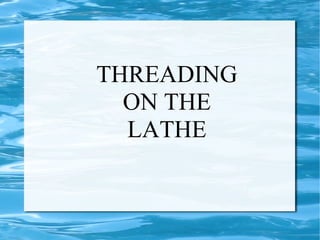
D:\Baring\Presentation
- 1. THREADING ON THE LATHE
- 2. INTRODUCTION
- 5. Threading. Lathe provided the first method for cutting threads by machines. Although most threads are now produced by other methods, lathes still provide the most versatile and fundamentally simple method. Consequently, they often are used for cutting threads on special workpieces where the configuration or nonstandard size does not permit them to be made by less costly methods. There are two basic requirements for thread cutting. An accurately shaped and properly mounted tool is needed because thread cutting is a form-cutting operation. The resulting thread profile is determined by the shape of the tool and its position relative to the workpiece. The second by requirement is that the tool must move longitudinally in a specific relationship to the rotation of the workpiece, because this determines the lead of the thread. This requirement is met through the use of the lead screw and the split unit, which provide positive motion of the carriage relative to the rotation of the spindle.
- 10. 1. First place the item to be threaded into the chuck and face it and turn it until everything is concentric and parallel. Lets assume we are doing an external thread. 2. Turn the job down until its diameter matches the diameter you need for your thread. For an M42 thread, I'll normally work to 42mm, and then cut in deeper until the item fits. 3. Securely mount the thread cutting tool in the tool post, making sure its tip is square the the job. Set the correct threading tool advance angle. 4. Change the change gears around to achieve the thread you require. My most common thread is 0.75mm pitch - which isn't on the instructions! However, lets assume we are doing a nice simple 1mm pitch thread.
- 11. 5.For a 1mm thread you will need to look at the chart. It says for 1mm we need 60,45,30,60. So adjust the change gears (being careful to not drop the woodruff keys into the swarf box) so that the 60 tooth gear is on the top gear on its own. Place the other 60 tooth gear on its own on the leadscrew gear. Then put the 45 and 30 tooth gears onto the centre spindle with the 45 gear on the inside. 6.Now look at the indicator table. For a 1mm thread, this tells us we need the 16T gear in the thread dial. I have never actually cut a thread that needs any of the other dial gears. It also tells us that valid start positions are 3,6,9 and 12. 7.Wheel the carriage up the far end away from the job, and engage the hlaf nut lock lever. With the lathe off, or running dead slow, engage the change gears. You should engage them so that the carriage starts to move slowly down the lathe towards the chuck. There are two positions
- 12. Threading, whether you are referring to external or internal threads can always be done with taps and dies, with the resulting thread almost always turning out satisfactory though sometimes a bit sloppy in my view. A tap or die must be started perfectly in line with the stock being threaded or the thread created will not run straight and true. All of these problems can and are usually taken care of by the use of tap guides and special die holders that can be mounted on the lathe insuring the initial alignment of the thread. Most old timers and those with a relatively large amount of machining experience will almost always thread on the lathe itself. How is this done, you ask? It 's easier than you think! Think about the way a carriage moves during an auto feed cut. The lead screw is linked to the carriage driven by a gear train connected to the head spindle.
- 13. Lathes that have auto feed carriages can be made to perform threading so such a lathe will be provided with a set of change gears or a built in, lever operated gear box to allow easy setting of gear train combinations for any thread pitch to be cut. A chart designating the combination and positioning of each gear is also provided with each lathe to make it simple to set up for each thread pitch. Assuming that one is making a small lead screw for a shop made slide that will have a dial calibrated for 50 thousands of inch per turn, the correct pitch would have to be a 20 tpi thread for it.